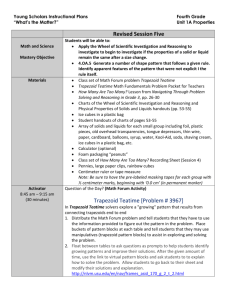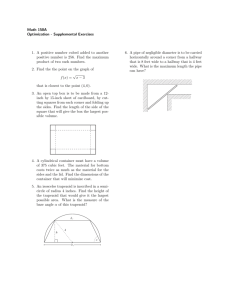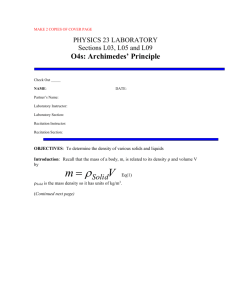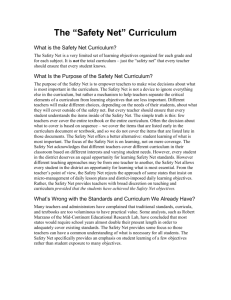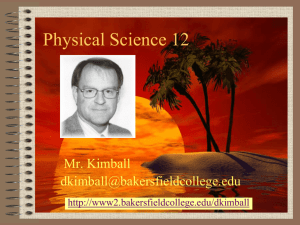Revised YSP Gr. 4 Session 5
advertisement
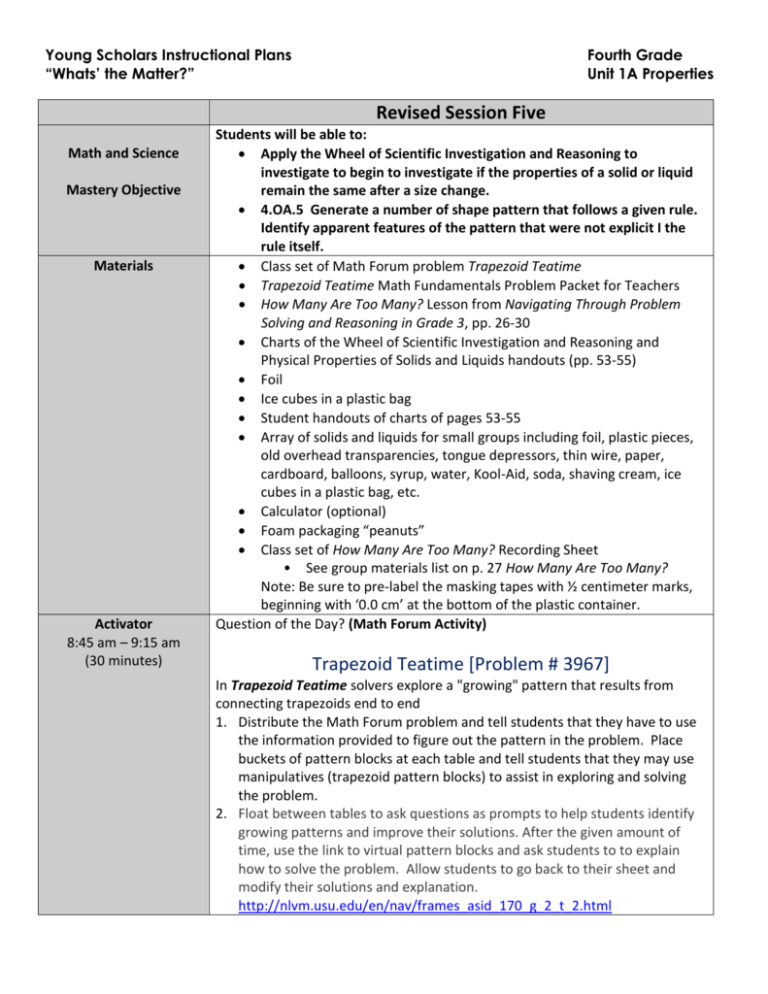
Young Scholars Instructional Plans “Whats’ the Matter?” Fourth Grade Unit 1A Properties Revised Session Five Math and Science Mastery Objective Materials Activator 8:45 am – 9:15 am (30 minutes) Students will be able to: Apply the Wheel of Scientific Investigation and Reasoning to investigate to begin to investigate if the properties of a solid or liquid remain the same after a size change. 4.OA.5 Generate a number of shape pattern that follows a given rule. Identify apparent features of the pattern that were not explicit I the rule itself. Class set of Math Forum problem Trapezoid Teatime Trapezoid Teatime Math Fundamentals Problem Packet for Teachers How Many Are Too Many? Lesson from Navigating Through Problem Solving and Reasoning in Grade 3, pp. 26-30 Charts of the Wheel of Scientific Investigation and Reasoning and Physical Properties of Solids and Liquids handouts (pp. 53-55) Foil Ice cubes in a plastic bag Student handouts of charts of pages 53-55 Array of solids and liquids for small groups including foil, plastic pieces, old overhead transparencies, tongue depressors, thin wire, paper, cardboard, balloons, syrup, water, Kool-Aid, soda, shaving cream, ice cubes in a plastic bag, etc. Calculator (optional) Foam packaging “peanuts” Class set of How Many Are Too Many? Recording Sheet • See group materials list on p. 27 How Many Are Too Many? Note: Be sure to pre-label the masking tapes with ½ centimeter marks, beginning with ‘0.0 cm’ at the bottom of the plastic container. Question of the Day? (Math Forum Activity) Trapezoid Teatime [Problem # 3967] In Trapezoid Teatime solvers explore a "growing" pattern that results from connecting trapezoids end to end 1. Distribute the Math Forum problem and tell students that they have to use the information provided to figure out the pattern in the problem. Place buckets of pattern blocks at each table and tell students that they may use manipulatives (trapezoid pattern blocks) to assist in exploring and solving the problem. 2. Float between tables to ask questions as prompts to help students identify growing patterns and improve their solutions. After the given amount of time, use the link to virtual pattern blocks and ask students to to explain how to solve the problem. Allow students to go back to their sheet and modify their solutions and explanation. http://nlvm.usu.edu/en/nav/frames_asid_170_g_2_t_2.html Young Scholars Instructional Plans Fourth Grade “Whats’ the Matter?” Unit 1A Properties Continue Session Four Lesson: How Many Are Too Many? (Part 1) Math and Science Navigating Through Problem Solving and Reasoning in Grade 3: pp. 26-30 Integrated Focus Lesson 1. Distribute student recording sheets. Provide a recap to Part 1 by having 9:15 am – 10:00 am students discuss their findings from using marbles to measure weight. (45 minutes) 2. Let the groups choose two additional units to repeat the investigation with other units. The groups should then discuss Questions 4-8 on the worksheet and try to agree o a group answer to each question. 3. In discussing the results of their investigation, the students should recognize that the heavier the unit, the fewer of the units they need to sink a boat. If you provided foam packaging material, they would see that the substance is too light to cause the boat to sink at all, and the results of their experiments should have “tested out” their conjectures. Note: Students will not complete the “extensions.” Sensory Break Archimedes' Discovery 10:00 am – 10:15 am 1. Provide brief story of Archimedes: The story goes that Archimedes was (15 minutes) given a job by the king - to determine whether the king of Syracuse was being cheated by a goldsmith who was suspected of providing the king with less than pure gold for a crown. Was it possible that the goldsmith substituted some of the gold he was given to make the crown, with some silver so that he could to keep some of the original gold for himself? While thinking about how to determine the purity of the gold, Archimedes lowered himself into a bath, noting the water displacement, and realized that a specific amount of water would be displaced in relation to an item's weight. At this point, Archimedes was so excited about his discovery that he ran from the bath into the public streets, yelling "Eureka!" 2. Tell students that they watch a short video connected to the Archimedes Principle of Buoyancy. It will provide an overview of key vocabulary terms that they must know during this unit. Show YouTube video animation: “Crown of Syracuse” http://www.youtube.com/watch?v=iGMUE_i4y1A 3. Ask students to connect back to the math Forum “Splish Splash” problem. “How is the increase in water level inside the tub, when each person got in, similar to how Archimedes found the density of an object when placed in a container full of water?” 4. Guide students in making initial connections. Introductory Lesson 10:00 am – 10:45 am (45 minutes) Closure 10:45 am-11:00 am (15 minutes) Lesson 4: What Scientists Do?: Observe, Question, Learn More 1. Communicate expectations for collaborative group work and science safety before beginning the lesson. 2. Project the Wheel of Scientific Investigation and Reasoning that is provided on the YSP MCPS wiki space as the components are explained during the lesson. Have each student complete the exit ticket “What did I learn today?” Once students complete their exit ticket, collect them, and prepare for dismissal. Young Scholars Instructional Plans “Whats’ the Matter?” Fourth Grade Unit 1A Properties Name ____________________________________ Date ___________________ Trapezoid Teatime [Problem #3967] Lipton Elementary School holds an annual tea to honor the parent volunteers who work in the school. The trapezoid tables they use can seat one person on each of the three short sides and two people on the long side. In other words, one table standing alone seats five people. The tables are arranged in one long row in the cafeteria. When they connect two tables together, here's how the seating looks: Questions: 1. How many guests can sit at 5 tables connected in a row? _______________ 2. How many guests can sit at 20 tables connected in a row? ________________ Explain how you found your answers. Describe any observations or patterns that helped you. Extra 1: Use words or numbers and symbols to write a rule for calculating the number of volunteers that can sit at any given number of tables. ____________________________________ Extra 2: How many tables would it take, arranged in a straight line, to seat 85 volunteers?____
